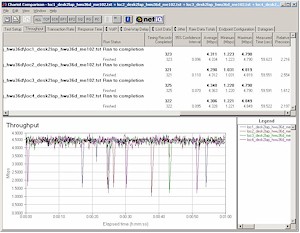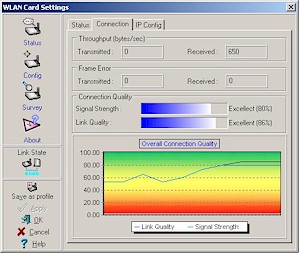Wireless Performance
NOTES
• Testing was done in a 1GHz Celeron notebook running WinXP home connecting to a NETGEAR ME102 802.11b Access Point
• Details of how we test can be found here.
I began my performance testing using NETGEAR's new WGT624, which uses Atheros' 802.11g chipset, as a test AP. The HWU associated without any problems, but try as I might, it would only connect at a 2Mbps rate. This resulted in a maximum throughput around 1Mbps. I next tried a Belkin F5D7130, based on Broadcom's 802.11g chipset, but obtained the same result - 2Mbps max connect rate with 1Mbps throughput.
When I reported the problem to Hawking, they said it was the first they'd heard of it and said they'd experienced no problems in tests with their own 802.11g products, which are based on GlobespanVirata's (Intersil) PRISM chipset. So I dug out a PRISM-based NETGEAR WG602, and confirmed that the HWU did, indeed, connect at 11Mbps and had throughput greater than 4Mbps.
Update 10/31/2003 Although Hawking is looking into possible solutions, they made no committments that the problem will be fixed. But they did say that they're planning to release an 802.11g version - dubbed the HWU54D - using Envara / Cypress Semi's USB G chipset at the end of November.
Experiments completed, I turned to my aged NETGEAR ME102 802.11b access point for the remainder of the throughput tests, which are summarized in Figure 6.

Figure 6: H-WU36D via NETGEAR ME102 throughput
(click on the image for a full-sized view)
For each test location, I played with antenna orientation to obtain the best signal. I found that the antenna was, as expected, directional and had best performance when its front was aimed in the general direction of my access point. But I found that, contrary to the information in Figure 3, I also got a useable, although not as good, signal when the back of the antenna was oriented to the access point. Pointing either side of the antenna panel pretty much killed the signal, however.
I found the Overall Connection Quality plot in Hawking's client utility (Figure 7) to be helpful in orienting the HWU for best signal.

Figure 7: Monitoring the connection
The refresh rate was sufficiently fast and the combination of instantaneous and time-based performance indicators gave me the required feedback for careful antenna aiming. The shot in Figure 7 was taken at my test location 2 and shows the signal strength variation over a 180 degree spin of the HWU. (The antenna was set to a vertical position and I started with the antenna back aimed at my test AP.)
Finally, note that there's no throughput hit when enabling WEP. But like most other 802.11b products, the HWU doesn't support Wi-Fi Protected access, either.